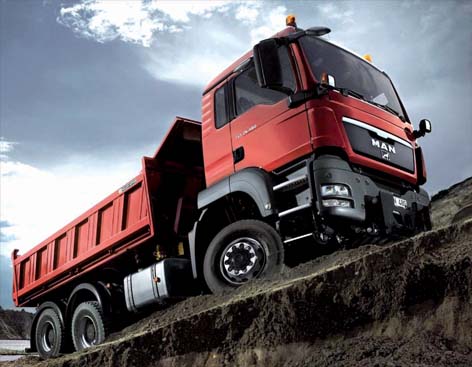 The year 2011 was particularly good for the MAN Group which successfully continued its international growth strategy. Growth in the commercial vehicles business was especially strong, while the results generated by the power engineering business area also remained at a high level.
The year 2011 was particularly good for the MAN Group which successfully continued its international growth strategy. Growth in the commercial vehicles business was especially strong, while the results generated by the power engineering business area also remained at a high level.
MAN companies really dominate their respective markets. The group operates through four divisions – MAN Truck & Bus, MAN Latin America, MAN Diesel & Turbo, and Renk – with a workforce of around 52,500 persons across 150 countries. Headed by MAN SE, which is its Corporate Center, the MAN Group generated revenue of Euro 16.5 billion and operating profit of Euro 1,483 million in 2011. Its return on sales increased from 7.1 per cent in the previous year to nine per cent. Although financial market uncertainties led to weakening momentum in the course of the year, the trend remained positive, leading to strong earnings for the group.
“MAN today stands for leading-edge technologies, international co-operation, customer orientation, and strong market positions. This can be seen in our key figures for 2011. MAN has generated record revenue of Euro 16.5 billion which is 12 per cent more than in the previous year”, says Dr. Georg Pachta-Reyhofen, Chief Executive Officer, MAN SE.
Impressive numbers
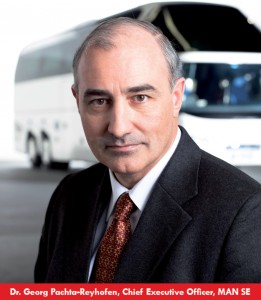 The revenue increase was largely due to the commercial vehicles business, which climbed 19 per cent to Euro 12.6 billion. The MAN Truck & Bus Division, which includes the European commercial vehicles business, improved significantly (+21 per cent), while MAN Latin America continued its success story with a 14 per cent increase. At Euro 4.0 billion, revenue in the power engineering was down slightly on the prior-year figure of Euro 4.2 billion. Of this amount, Euro 3.6 billion was attributable to MAN Diesel & Turbo and Euro 0.4 billion to Renk.
The revenue increase was largely due to the commercial vehicles business, which climbed 19 per cent to Euro 12.6 billion. The MAN Truck & Bus Division, which includes the European commercial vehicles business, improved significantly (+21 per cent), while MAN Latin America continued its success story with a 14 per cent increase. At Euro 4.0 billion, revenue in the power engineering was down slightly on the prior-year figure of Euro 4.2 billion. Of this amount, Euro 3.6 billion was attributable to MAN Diesel & Turbo and Euro 0.4 billion to Renk.
Orders generated by the MAN Group in 2011 amounted to Euro 17.1 billion, up 14 per cent. This is due above all to the commercial vehicles business, which saw an increase of 17 per cent. Operating profit rose 43 per cent to Euro 1.5 billion in fiscal 2011. Commercial vehicles contributed Euro 965 million of this figure, up an impressive 83 per cent.
The year also saw Volkswagen AG being formally confirmed as MAN’s majority shareholder following the closing in November. As a result, Volkswagen now holds 55.90 per cent of MAN SE’s voting rights and 53.71 per cent of its share capital. MAN will be an additional major pillar contributing to the VW Group’s success. At the same time, the co-operation with the VW Group will boost MAN’s growth trajectory and further expand its position as one of the world’s leading transport-related engineering groups.
CV business
MAN Truck & Bus is one of Europe’s leading manufacturers of commercial vehicles, with production facilities in four European countries, South Africa, and India. Its products range from trucks with a gross vehicle weight of 7.5 to 44 tonne for all uses, special-purpose vehicles with a gross train weight of up to 250 tonnes through buses and coaches, to combustion ignition and spark-ignited engines for on- and off-road uses.
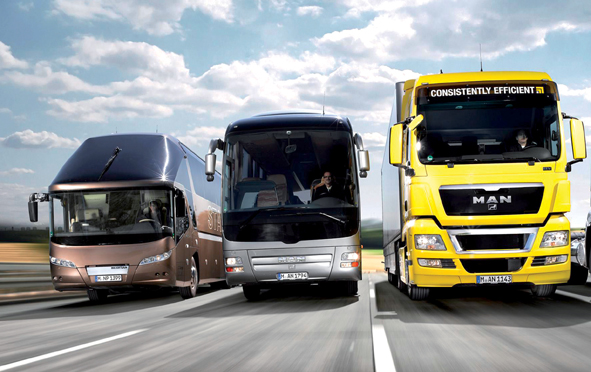 MAN Finance International GmbH, Munich, and the national companies allocated to it offer financing solutions, in particular leases and rentals, to commercial vehicle customers. These activities are supported by an international sales and service network.
MAN Finance International GmbH, Munich, and the national companies allocated to it offer financing solutions, in particular leases and rentals, to commercial vehicle customers. These activities are supported by an international sales and service network.
“In the commercial vehicles business area, the main focus will continue to be on ensuring passenger and goods transportation is as efficient and hence as resource-friendly as possible. MAN has laid the groundwork for this with hybrid solutions for city buses and delivery trucks. We are also working on optimized aerodynamic designs, which in the aggregate can lead to substantial fuel and CO2 savings. In addition, our external engines business is becoming increasingly important. Our goal in this area is to leverage our expertise and our strong brand to open up additional prospects”, adds Dr. Pachta-Reyhofen.
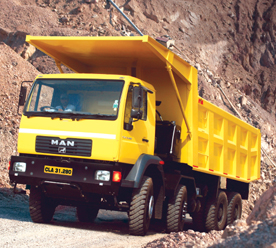 MAN Latin America is Brazil’s largest truck manufacturer and the country’s market leader for trucks with a permissible gross vehicle weight of more than 5 tonne. MAN Latin America produces trucks and buses in Resende, Brazil, and Querétaro, Mexico. Its vehicles are primarily sold in Latin America and Africa. It delivered 72,102 trucks and buses in 2011.
MAN Latin America is Brazil’s largest truck manufacturer and the country’s market leader for trucks with a permissible gross vehicle weight of more than 5 tonne. MAN Latin America produces trucks and buses in Resende, Brazil, and Querétaro, Mexico. Its vehicles are primarily sold in Latin America and Africa. It delivered 72,102 trucks and buses in 2011.
Profitable international growth
Over the past few years, MAN has strategically expanded its international presence. This minimizes the risks associated with the economic fluctuation of individual markets and regions, for instance. Demand will remain high in emerging economies over the coming years, providing further growth impetus for MAN. However, Europe will remain MAN’s core market and offers a healthy balance between growth and profitability.
At the same time, MAN’s first priority will continue to be driving forward the BRIC strategy. MAN Latin America leads the commercial vehicle market in Brazil, offering products tailored to emerging economies at the upper end of the budget market. MAN Latin America’s bid for leadership across the whole of Latin America is underlined by new products and increased capacity. MAN is investing in a production facility with an annual capacity of around 6,000 vehicles at its St. Petersburg site in Russia.
In India, MAN Truck & Bus signed an agreement to fully acquire the joint venture with FORCE Motors Ltd., Akurdi. The production and sale of the MAN CLA in the Indian market will now be driven solely by MAN. In China, the new joint brand with Sinotruk, SITRAK, has been specifically and systematically tailored to the budget segment and will primarily serve the Chinese market, and later other rapidly growing, emerging economies in Asia, Africa, the Middle East, and the CIS region.
MAN Truck & Bus maintained its strong performance of the previous year in fiscal 2011. Double-digit increases in order intake and revenue enabled it to more than triple operating profit year-on-year.
At Euro 9.5 billion, order intake in fiscal 2011 was 19 per cent above the prior-year level (Euro 8 billion). Revenue rose by 21 per cent from Euro 7.4 billion in the previous year to Euro 9 billion. Significantly higher unit sales saw operating profit increase by Euro 407 million to Euro 565 million compared with the previous year’s (Euro 158 million).
Economic environment
The European commercial vehicles market continued to recover in 2011. The market volume in the segment for trucks over 6 tonne increased from 235,000 units in 2010 to around 306,000 units (+ 30 per cent). MAN Truck & Bus was able to lift its market share in this segment from 16.8 per cent in the previous year to 17.9 per cent. At 28,500 units, the European bus market remained almost on a level with the previous year (28,000). Here, MAN Truck & Bus was able to increase its market share from 13.3 per cent to 13.8 per cent. The highest growth was achieved in the intercity bus segment.
The trucks business lifted its order intake from Euro 6.9 billion in the previous year to Euro 8.2 billion. The number of trucks ordered was up by 27 per cent from 61,934 to 78,635 units. This growth was driven in particular by order intake for heavy trucks, which increased by 31 per cent. MAN Truck & Bus delivered 77,643 trucks and 5,775 buses, recording a 38 per cent rise compared with the previous year (55,166 trucks, 5,483 buses). Revenue rose by Euro 1.5 billion to Euro 9.0 billion, with revenue from the Trucks business climbing by 23 per cent to Euro 7.7 billion and the buses business recording a six per cent increase in revenue to Euro 1.2 billion.
Outlook
The outlook for the global commercial vehicles market is not bright enough due to the decline in economic growth rates and financial market uncertainties. Growth momentum is likely to weaken in 2012, meaning that demand for commercial vehicles in Europe will be roughly on a level with the previous year. Europe remains MAN Truck & Bus’s core market. At the same time, MAN continues to pursue its international growth strategy, which is focused mainly on the BRIC countries.
Going forward, there will continue to be considerable differences between the BRIC countries and the European market environment in terms of market requirements, demand preferences and general price acceptance. While innovation, equipment and costs per kilometre driven will remain the key success factors for high-margin business in the European market, that in the BRIC countries continues to be directed very much by the vehicle price. MAN Truck & Bus serves these regions with appropriately tailored products and concepts.
In China, the SITRAK will serve China and other growth markets in Asia, Africa, the Middle East, and the CIS. Sales are scheduled to start in 2013. By 2018, the aim is to reach annual unit sales of some 200,000 units, of which around 160,000 are set to be recorded in the Chinese market. MAN will also participate in sales in China through the interest in Sinotruk.
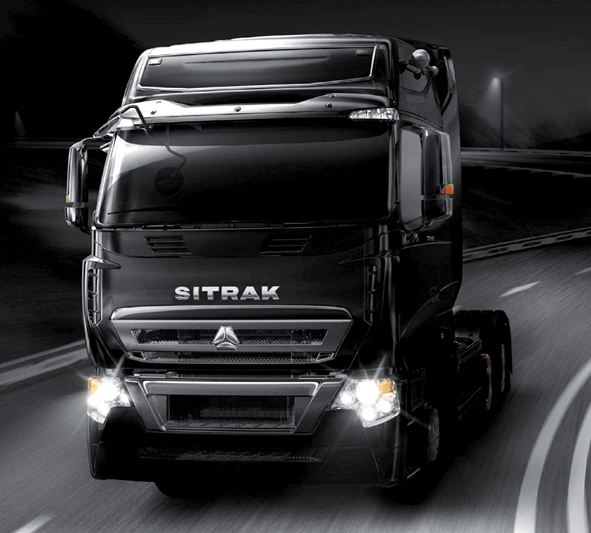 In the Indian market, MAN Truck & Bus now has sole responsibility for the production and sale of the MAN CLA in and outside of India after acquiring the shares of Force Motors in the Indian JV.
In the Indian market, MAN Truck & Bus now has sole responsibility for the production and sale of the MAN CLA in and outside of India after acquiring the shares of Force Motors in the Indian JV.
The long-term strategic investment by MAN Truck & Bus underscores the immense importance of the Indian market in the context of its BRIC strategy. It is continuing to expand the external engines business, a strategic business area with considerable growth potential, and develops and produces common rail diesel engines, which are used in MAN trucks and buses. Other manufacturers also use MAN engines, installing them in commercial vehicles, construction and agricultural machinery, track vehicles and yachts.
In October 2011, for instance, MAN announced the delivery of 2,188 engines to the bus manufacturer LIAZ, a subsidiary of Russia’s GAZ Group. The management of MAN Truck & Bus expects revenue in 2012 to be on a level with the previous year. While the return on sales will decrease slightly, the company will continue to work on sustainably increasing earnings quality in a challenging market environment.
Long-term growth strategy
The MAN Group will continue to pursue its profitable growth strategy with its focus on transportation and energy. A key part of this strategy is international growth. MAN is systematically expanding its presence around the globe, particularly in the BRIC countries, as well as the emerging economies in East Asia and South America. Focus is also on the expansion of after-sales operations in all business areas.
Technology leadership is a key success factor for MAN which develops products and solutions that meet the needs of customers and markets. Its focus is on reducing fuel consumption and emissions, as well as generating energy that is efficient, reliable, and environmentally friendly.
The close co-operation among MAN, Volkswagen and Scania opens up significant potential synergies and will positively influence the growth of the MAN Group. Close co-operation in manufacturing, as well as in research and development, offers substantial potential over the long term and the MAN Group will play an active role in leveraging these synergies. The first project groups have been established and have started working on this.
It will be interesting to watch MAN’s strategy unfold as the year goes by, keeping in mind the dynamics, uncertainties and challenges posed by various market conditions across the globe. The company, with new synergies and plans under its belt, looks set to maintain its strong growth across its various global markets and would also be eager to make inroads into newer territories to further expand its global footprint.